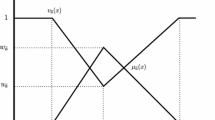Abstract
In this paper, we attempt to introduce an algorithm which considers not only time factor but also cost, risk, and quality criteria to determine the critical path under fuzzy environment. In this algorithm first, decision makers allocate time, cost, risk, and quality to each activity. We are lacking in data and information, so in the proposed algorithm, the ratings of each activity and the weight of each criterion are described by fuzzy numbers and linguistic variables, which can be expressed in triangular fuzzy number. Linguistic variables are applied to represent the intensity of preferences of one criterion over another. Then, we add up triangular fuzzy numbers to determine the final evaluation value of each criterion for paths. Next, we use fuzzy TOPSIS, a technique for order preferences by similarity to an ideal solution, a method proposed by the authors in another paper, to choose the best alternative. Finally, numerical example is solved to illustrate the procedure of proposed method at the end of this paper.
Similar content being viewed by others
References
Chen SP (2007) Analysis of critical paths in a project network with fuzzy activity times. Eur J Oper Res 183:442–459
Kelley JE (1961) Critical path planning and scheduling mathematical basis. Oper Res 9:296–320
Hillier FS, Lieberman GJ (2001) Introduction to operations research, 7th edn. McGraw-Hill, Singapore
Zadeh LA (1978) Fuzzy sets as basisfor a theory of possibility. Fuzzy Sets Syst 1:3–28
Chanas S, Zielinski P (2001) Critical path analysis in the network with fuzzy activity times. Fuzzy Sets Syst 122:195–204
Chen CT, Huang SF (2007) Applying fuzzy method for measuring criticality in project network. Inf Sci 177:2448–2458
Slyeptsov AI, Tyshchuk TA (2003) Fuzzy temporal characteristics of operations for project management on the network models basis. Eur J Oper Res 147:253–265
Zammori FA, Braglia M, Frosolini M (2009) A fuzzy multi-criteria approach for critical path definition. Int J Project Manage 27:278–291
Zielinski P (2005) On computing the latest starting times and floats of activities in a network with imprecise durations. Fuzzy Sets Syst 150:53–76
Shipley MF, Korvin A, Omer K (1997) BIFPET methodology versus PERT in project management: fuzzy probability instead of the beta distribution. J Eng Tech Manage 14:46–65
Chanas S, Dubois D, Zielinski P (2002) On the sure criticality of tasks in activity networks with imprecise duration. IEEE Transactions on Systems, Man, and Cybernetics-Part B 32:393–407
Chanas S, Zielinski P (2002) The computational complexity of criticality problems in a network with interval activity times. Eur J Oper Res 136:541–550
Atkinson R (1999) Project management: cost, time and quality, two best guesses and a phenomenon, it’s time to accept other success criteria. Int J Project Manage 17:337–342
PMI Standards Committee (1996) A guide to the project management body of knowledge, 3rd edition. Project Management Institute.
Cagno E, Caron F, Perego A (2001) Multi-criteria assessment of the probability of winning in the competitive bidding process. Int J Project Manage 19:313–324
Lin CT, Ying TC, Frosolini M (2004) Bid no bid decision making, a fuzzy linguistic approach. Int J Project Manage 22:585–593
Kamal M, Al-Subhi AH (2001) Application of the AHP to project management. Int J Project Manage 19:19–27
Mahdi I, Alreshaid K (2005) Decision support system for select the proper project delivery method using analytical hierarchy process (AHP). Int J Project Manage 23:567–572
Meade LA, Presley A (2002) R&D project selection using ANP. IEEE Potential 21(2):22–28
Buckley JJ (1985) Fuzzy hierarchical analysis. Fuzzy Sets Syst 17:233–247
Chen CT (2000) Extensions of the TOPSIS for group decision-making under fuzzy environment. Fuzzy Sets Syst 114:1–9
Kaufmann A, Gupta MM (1985) Introduction to fuzzy arithmetic: (theory and application). Van Nostrand Reinhold, New York
Klir G, Yuan B (1995) Fuzzy sets and fuzzy logic: theory and applications. Prentice-Hall, Upper Saddle River
Zadeh LA (1975) The concept of a linguistic variable and its application to approximate reasoning. Inform Sci 8(I):199–249, 301–357(II)
Zimmerman HJ (1996) Fuzzy set theory and its applications, 3rd edn. Kluwer, Norwell
Chen CT, Lin CT, Huang SF (2006) A fuzzy approach for supplier evaluation and selection in supply chain management. Int J Prod Econ 102:289–301
Chen SJ, Hwang CL (1992) Fuzzy multiple attribute decision making: methods and application. Springer, Berlin
Hwang CL, Yoon K (1981) Multiple attribute decision making: methods and applications. Springer, Berlin
Yager RR (1981) A procedure for ordering fuzzy subsets of the unit interval. Inf Sci 24:143–161
Author information
Authors and Affiliations
Corresponding authors
Rights and permissions
About this article
Cite this article
Amiri, M., Golozari, F. Application of fuzzy multi-attribute decision making in determining the critical path by using time, cost, risk, and quality criteria. Int J Adv Manuf Technol 54, 393–401 (2011). https://doi.org/10.1007/s00170-010-2928-4
Received:
Accepted:
Published:
Issue Date:
DOI: https://doi.org/10.1007/s00170-010-2928-4




